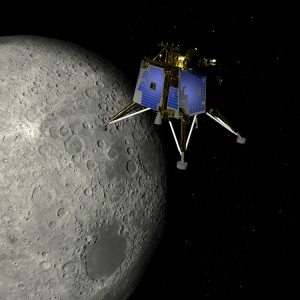Lunar Failings: Space is Hard
September 13, 2019
Last week, on September 6, an up-and-coming space agency fell just short of its goal. About 1 mile (1.5 kilometers) above the moon’s surface, the India Space Research Organization (ISRO) lander Vikram deviated from its landing course and disappeared from radio contact. Vikram was to be the crowning stage of Chandrayaan-2 (Mooncraft-2), ISRO’s second lunar mission.

This artist’s depiction shows Chandrayaan-2′s lunar lander, Vikram, approaching the moon. Credit: © Raymond Cassel, Shutterstock
India was endeavoring to become the fourth country to make a soft landing (a landing that does not destroy the craft) on the surface of the moon, after the United States, the former Soviet Union, and China. Vikram would have been the first lander near the moon’s south pole, a region full of water ice and other minerals that could one day be the site of a permanent base. Vikram would have deployed a rover to explore the landing site. The Chandrayaan-2 orbiter, which had launched Vikram, located the lander on the surface of the moon a few days after its disappearance. ISRO reported that Vikram had apparently made a “hard landing,” and the lander did not respond to contact attempts.
Before the recent failure, ISRO had been riding a wave of success. In 2008, the agency deployed its first lunar satellite, Chandrayaan-1. Chandrayaan-1 mapped the moon’s surface for about a year. The satellite also released a hard lander that impacted the lunar surface. In 2013, ISRO launched the Mars Orbiter Mission, called Mangalyaan (Marscraft). The satellite overcame a minor engine failure to reach Martian orbit in September 2014.
ISRO’s failed soft landing on the moon comes on the heels of another prominent lunar failure. In April 2019, the lander Beresheet (In the Beginning), developed by the Israeli company SpaceIL, slammed into the moon when its main engine cut out unexpectedly. SpaceIL had hoped to become the first private company to place a lander on the moon’s surface. It had been one of the competitors for the Google Lunar X Prize. The contest would have awarded $20 million to the first company to achieve a soft landing on the moon. But none of the competitors attempted a landing, even after several deadline extensions, so the prize was withdrawn. The Israeli project cost about $100 million, a fraction of what a similar mission by the United States National Aeronautics and Space Administration (NASA) would have cost, but it took greater risks and ultimately failed.
The process of landing is the most dangerous phase of a lander’s mission. Many different systems must work perfectly for the lander to bring itself to a halt on the surface. Any malfunction is usually catastrophic. At other points in a mission, such as in transit to or in orbit around another body, engineers have plenty of time to identify and work around problems with a spacecraft. But this cannot be done in the time-sensitive environment of landing.


